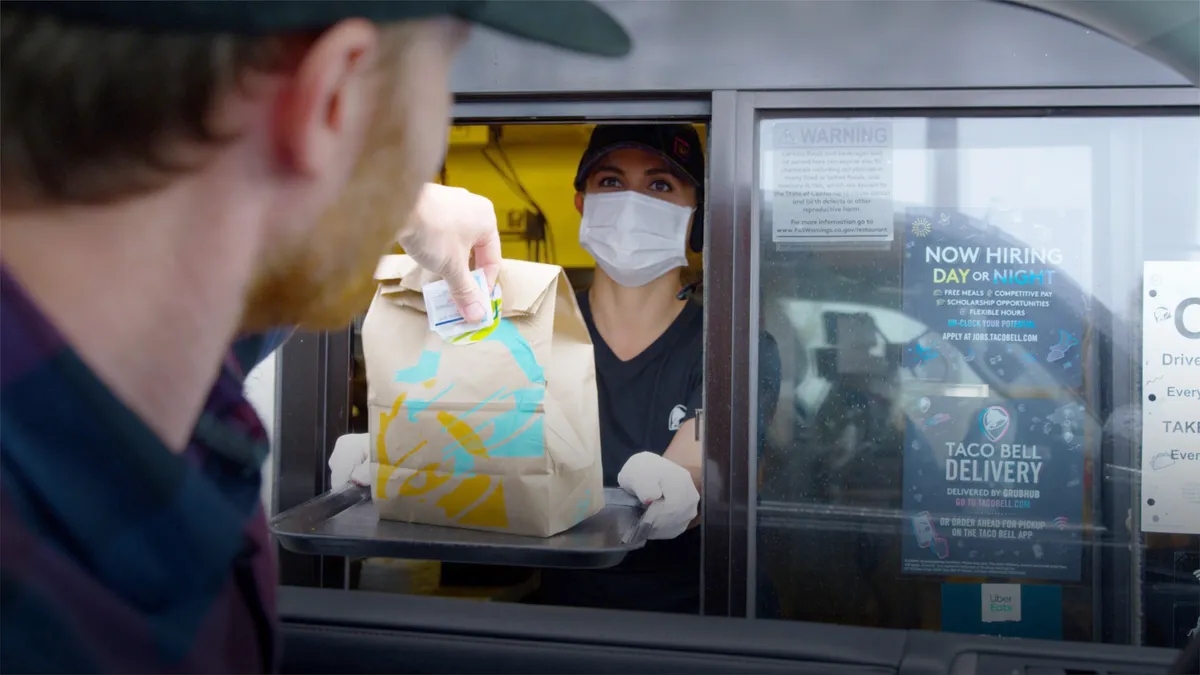Dive Brief:
- The $1,400 stimulus checks rolling out to consumer's bank accounts as part of the $1.9 trillion American Rescue Plan are expected to lift restaurant sales by as much as 20% to 30% during the next several weeks, according to a report from Rabobank using Earnest Research.
- This forecast is double what the previous two rounds of stimulus checks provided restaurants. During the four weeks immediately after those payments were made, restaurant spending was up 10% to 15%. Delivery spending in particular grew by 24 to 50 percentage points during the first stimulus and about 20 to 40 percentage points during the second stimulus round.
- The quick-service and fast casual restaurant segments both experienced a significant boost from stimulus payments, with high single-to-low double-digit sales lifts following the first two rounds. Conversely, casual and fine dining received no perceptible lift from the first stimulus — due to lingering dining room closures, fewer off-premise options and a different income audience — and a nominal lift from the second stimulus.
Dive Insight:
Nearly 30% of Americans spent their first stimulus check on consumption, including food, according to data from the New York Federal Reserve. Comparatively, 36% saved their money, while 35% used that $1,200 check to repay debts. That initial stimulus took effect in March 2020 as part of the CARES Act and rolled out throughout April. At that time, dine-in shutdowns were in place across much of the country, which reflects why delivery and drive-thru-heavy quick-service concepts fared well.
At $600, the second stimulus was much smaller, but still contributed to sales lifts in the industry, including casual dining concepts like Beef O' Brady's, which experienced a 6.5% increase in sales from the checks in January 2021 compared to December 2020, according to The Wall Street Journal. Domino's CEO Ritch Allison and McDonald's CEO Chris Kempczinski also credited stimulus checks for sales lifts during their companies' most recent earnings calls.
The initial two stimulus rounds have proven that consumers use that cash infusion at restaurants, and the estimated forecast is bigger this time around simply because the stimulus check allotment is larger. Rabobank predicts the coming sales lift will also be more uniformly distributed among segments, especially with more dine-in options available compared to last year.
The analysts also predict the bump will likely build "a bridge to a more comprehensive sales recovery as [COVID-19] vaccinations speed up." About one-third of U.S. adults have received at least one dose of a COVID-19 vaccine as of arch 29, and President Joe Biden moved up the deadline to make all adults eligible for the vaccine by April 19.
The stimulus and vaccination rollout are both positive developments for a weary restaurant industry that lost an estimated $240 billion in 2020 and more than 10% of U.S. eateries. Warmer weather may provide an additional tailwind for restaurants that are able to leverage expanded outdoor dining. In fact, nearly 60% of casual operators have added outdoor dining since the start of the pandemic.
The biggest tailwind of all came last month when the $28.6 billion Restaurant Revitalization Fund was passed by Congress. The Small Business Association expects the fund to begin its phased rollout this month. The grants will cover payroll costs, principal and interest payments on a mortgage, rent, utilities, maintenance, supplies, supplier costs, operational expenses and food and business expenses.
All of these trends may be enough to push restaurants to a full recovery. The road remains bumpy, however. Despite the accelerated vaccine rollout, COVID-19 cases have jumped for the fourth straight week due to the proliferation of new variants. This could create additional uncertainty about regulations, as well as consumer anxiety. Perhaps that is why the National Restaurant Association predicts that restaurants will not see sales rebound to pre-pandemic levels until 2022.









